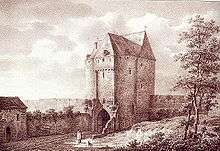Namur Gate

The Namur Gate (French: Porte de Namur; Dutch: Naamsepoort) was one of the gates of the second walls of Brussels. It used to be called the New Gate of Coudenberg, to distinguish it from the old gate located in the first walls, and it used to connect the rue Entre deux Portes (current rue de Namur) to chemin d'Ixelles (current chaussée d'Ixelles). The twenty-first century 'Porte de Namur' denotes rather the Ixelles district of that name, than the disappeared building.
Porte de Namur

During the construction of the boulevards of the small ring, two neoclassical former pavilions of octroi were raised there by the architect Auguste Payen (collaborator of Nicolas Roget, architect of the City of Brussels) in 1836. The octroi was abolished in 1860, the buildings were moved to the entrance of Bois de la Cambre three years later. Removing barriers then permitted Namur area to develop.
In 1866, the pavilions were replaced by the monumental Brouckère fountain, designed by the architect Henri Beyaert and by the two sculptors Pierre Dunion and Edouard Fiers, which was raised in memory of Burgomaster Charles de Brouckère. The monument was dismantled in 1955 to allow the rearrangement of boulevards in preparation for Expo 58.[1]
References
- ↑ Michel Hainaut & Philippe Bovy, À la découverte de l'histoire d'Ixelles : Porte de Namur. Ixelles, April 2000, 16 p.
Coordinates: 50°50′18″N 4°21′43″E / 50.83833°N 4.36194°E
